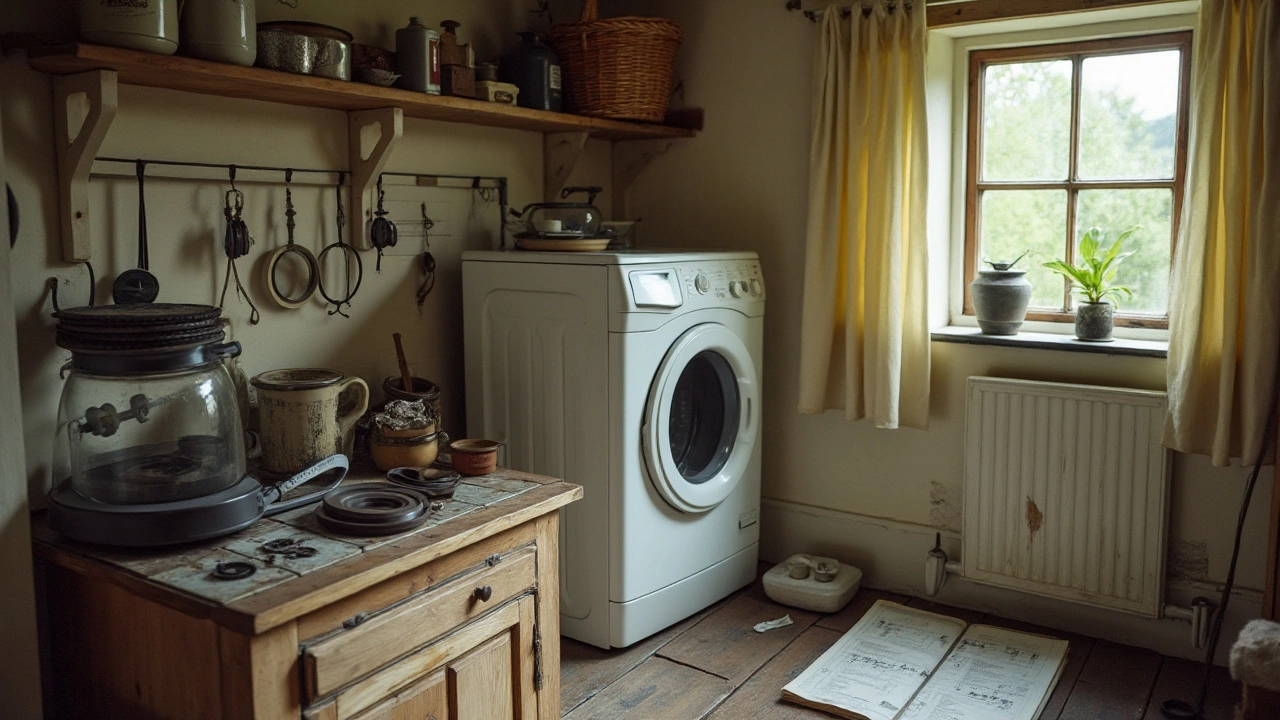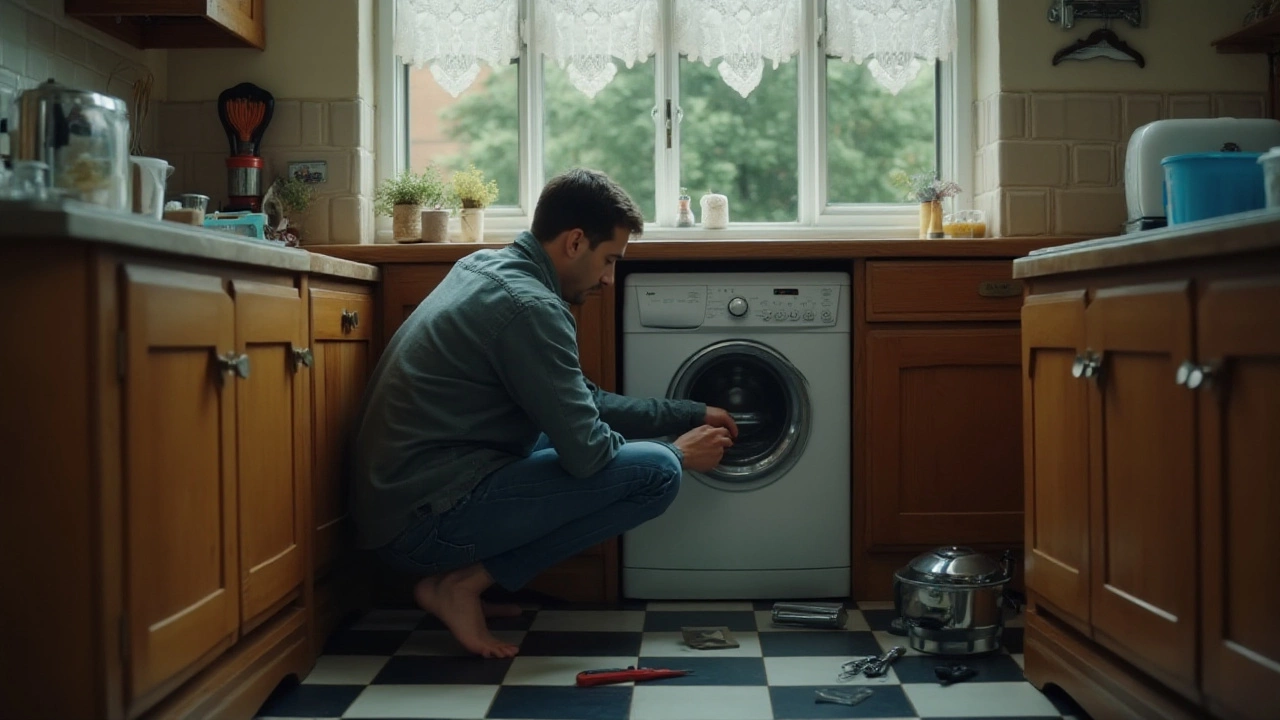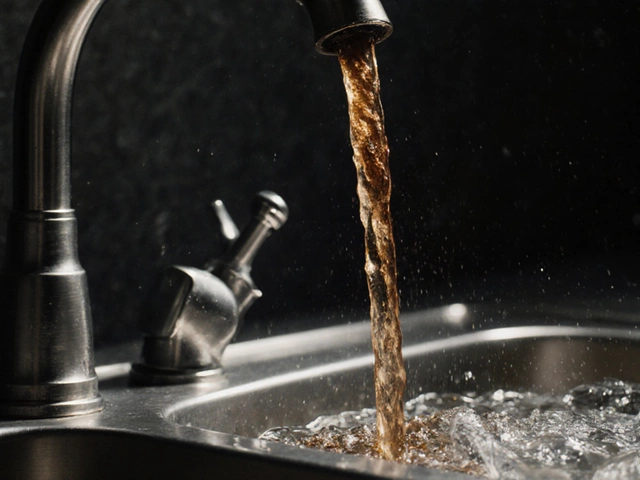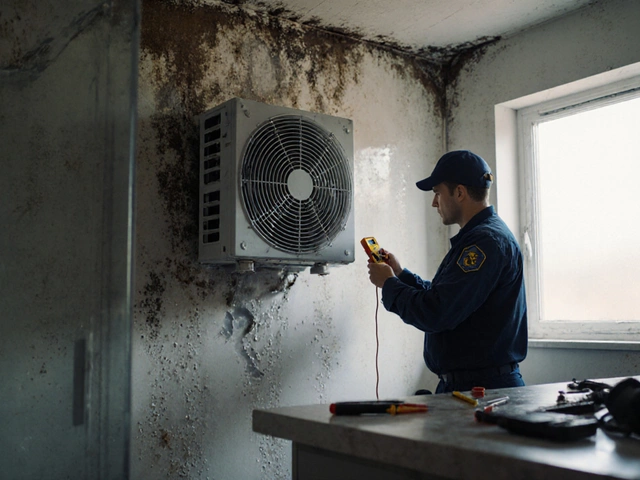Washing machines have a sneaky way of becoming an essential part of our daily routine. One minute you're tossing in a load of laundry, and the next, you're faced with a stubborn machine refusing to do its job. Although these appliances seem invincible, they can run into trouble over time, much like any other household gadget.
Knowing which parts are prone to breaking down can be a lifesaver. Whether it's a fudged belt, a lazy pump, a stammering motor, or something else entirely, understanding these common problems could save you from unexpected downtime and expensive repair bills. Let's unravel the mystery behind these mechanical workhorses and figure out how to keep them spinning smoothly.
- Understanding the Basics: How Washing Machines Operate
- Common Parts Prone to Failure
- Tips for Diagnosing Issues
- DIY Repairs and When to Call a Professional
- Preventive Maintenance for Longevity
Understanding the Basics: How Washing Machines Operate
Washing machines have woven themselves into the fabric of modern life, making the arduous task of laundry as simple as pressing a button. At the heart of every washing machine, whether it's a top-loader, front-loader, or something fancier like a high-efficiency model, lies the same fundamental process: wash, rinse, spin, repeat. Each cycle harnesses the synergy between mechanics and physics, effectively blending water, detergent, and your clothes in a rhythmic dance designed to banish dirt and odors.
A typical washing machine consists of several key components, each playing a pivotal role. The drum, the most prominent feature, holds your laundry and rotates it during the wash and spin cycles. Within this container lies the agitator or impeller, responsible for swirling water and clothes together to ensure optimal cleaning. The control panel, resembling a cockpit dashboard, allows users to choose settings that best fit their load, such as cycle duration, water temperature, and spin speed. But these choices only translate into action through the motor, the powerhouse that generates the motion necessary for cleaning.
Another fascinating part to explore is the water pump, which regulates water flow in and out of the drum during rinsing phases. Meanwhile, a series of valves and switches ensures that water enters and exits efficiently, while maintaining precise levels to prevent flooding your laundry room. And let’s not overlook the significance of the timer—the machine’s brain, orchestrating cycle progress with military precision. An intricate network of electrical connections backs this orchestration, translating button-presses into mechanical movements.
“The beauty of the washing machine lies in its simplicity,” says John Smith, an appliance engineer with over 20 years of experience.
“Despite its apparent complexity, it essentially mimics the process of scrubbing clothes by hand. Each component and cycle serves the ultimate goal of eliminating grime while protecting fabric integrity.”This ingenious simplicity is what makes washing machine repair—and eventual mastery—both an art and a science. Every clink and hum tells a tale of balance between strength and delicacy, a testament to the appliance’s evolution over the decades.
Common Parts Prone to Failure
Washing machines, in all their mechanical glory, are a cacophony of parts working harmoniously to tackle our laundry woes. Among these, there are certain components notorious for calling it quits sooner than we would like. Take belts, for example; they are akin to the unsung heroes, quietly ensuring everything spins as it should. But wear and tear is their kryptonite, leading to unexpected slips and stalls. Belts usually present signs of their impending doom with loud screeches or outright refusal to move. Replacing them might not be everyone's cup of tea, yet understanding their importance can turn a potential disaster into a simple fix.
The pump is another vital component often at the mercy of blockage or fatigue. Water circulation is its forte, but the accumulation of grime may spell trouble. When a machine decides to hold onto water longer than it should, the pump's failure might be the culprit. Clearing obstructions or replacement when necessary can breathe fresh life into your trusty appliance. This might sound like a weekend project, but with the right approach, it can be more straightforward than daunting. Interestingly, according to a repair expert in an interview highlighted in
Consumer Reports, "Regularly checking the pump filters and ensuring nothing gets lodged can improve your washing machine's lifespan."
Motors, the powerhouse behind the wash, are robust but not immortal. Age and overstress can lead to brushes wearing out or bearings turning obstinate, resulting in seized operations. If there's one telltale sign, it's usually unusual noises or vibrations. Replacing motor parts might be a bit of a puzzle, but understanding the motor's role makes certain failures more predictable and, thus, manageable. A bit of technical jiggery-pokery is sometimes all a motor needs to resume its duties. An intriguing fact: washing machine motors have been repurposed for DIY projects, showcasing their resilience beyond the laundry room.
Let's not forget about seals and gaskets—the unsung stewards of dry floors. These parts work silently to prevent leaks but degrade over time, particularly due to mildew. A sudden pool forming near your machine could be a whispered warning from these valiant defenders. Inspecting them for cracks and replacing them as needed might sound trivial, but such maintenance is crucial for preventing soggy mishaps.
Considering the intricacy involved, it pays to know what makes these parts so vital. When you've listened to the clunky symphony of a faltering machine, recognizing and promptly addressing failing parts can avoid considerable inconvenience. A tiny effort into knowledge could translate into saved time and expenses later on. Remember, like any piece of intricate machinery, your washing machine demands respect and a bit of tender loving care.

Tips for Diagnosing Issues
Figuring out what's going wrong with your washing machine might seem like a task for a tech-savvy genius, but it's something you can tackle with a bit of curiosity and patience. Think of it like unraveling a mystery where the clues are right there in the machine’s behavior. First, take note of any unusual noises. A thumping sound may scream 'loose drum,' while a grinding noise could point to worn-out bearings. Keep your ears peeled like a detective in a noir movie. Listening can often reveal more about the issue than a quick glance ever could.
Next, pay attention to the water flow. Is the washing machine refusing to fill, or maybe it doesn't seem to be draining properly? A trickle of water could suggest a clogged inlet screen, while an endlessly draining one might be related to a problem with the pump. Take a look at the hoses — are they crimped or blocked? Keeping an eye on the water itself can often lead you straight to the culprit, steering you towards an efficient washing machine repair.
Sometimes the issue is with the spin cycle, where clothes come out wetter than they should be. This might indicate a problem with the drive belt or motor coupler. Open the machine's top or back panel carefully, and inspect for any signs of wear and tear. Finding a snapped or frayed belt could be the aha moment you're searching for. Make sure you’ve unplugged the machine before diving in; safety should always come first. Speaking of which, have some basic tools like a screwdriver set handy, just in case you need to dig deeper.
"Remember, diagnosing washing machine problems is much like piecing together a jigsaw - challenging, yet immensely satisfying," advises Jack Thompson, seasoned appliance technician.
Don't forget the simple stuff—make sure the machine is well balanced. After moving heavy loads, the machine can get uneven, causing it to wobble and potentially damage the drum or other sensitive parts. Use a spirit level to check the balance and gently adjust the machine's feet if necessary, this small step can sometimes make a world of difference. Imagine a tightrope walker; a minor imbalance can send them tumbling just as easily as your washing machine. It's often these little checks that prevent big headaches later on.
As you diagnose, it's crucial to keep a record of any persistent issues. Create a simple chart or table to log when the problem happens, what noises you hear, and any action you take. Here’s a basic example you might follow:
| Date | Problem | Notes |
|---|---|---|
| 14-Jan-2025 | Not spinning correctly | Checked drive belt, found worn spots |
| 15-Jan-2025 | Leaking water | Identified loose hose connection |
By taking charge and keeping documentation, you're not just fixing your washing machine. You're gaining a deeper understanding of this essential appliance, potentially saving both time and money. And remember, while DIY repairs can be immensely rewarding – when in doubt, don't hesitate to call in a professional, especially for complex or dangerous jobs.
DIY Repairs and When to Call a Professional
Embarking on a DIY repair journey for your washing machine often starts with good intentions. After all, who wouldn’t want to save a little money while gaining some hands-on experience with their beloved appliance? It’s important, however, to approach this task with caution and a solid understanding of basic appliance troubleshooting. The internet is a treasure trove of resources, from video tutorials to step-by-step guides, that can turn even a novice into a temporary repair tech. But before you grab your tools, consider the complexity and potential risks that come with fixing these machines. Knowing your limits could save not only your washing machine but your sanity too.
One of the most common repairs that adventurous DIYers tackle is replacing a faulty belt. The belt is a critical component of a washing machine, responsible for driving the tub's movement. If you hear that unmistakable squeal or notice the drum not spinning properly, it might be time to give it a closer look. To replace it, ensure that you have the correct size belt for your model and follow an illustrated guide for disassembly. With patience and precision, many find success without professional help. However, if the drum is jammed or the motor seems off-kilter, it’s time to pause and evaluate if calling in the experts is worth a shot.
Other relatively straightforward fixes include cleaning a clogged filter or unblocking a drain pump. These components can accumulate debris over time, affecting the machine maintenance. Unplug your machine, locate the filter or pump—usually, there’s an easy-to-remove panel—clean, and reassemble. You might be surprised at how often this simple action restores functionality. Yet, when attempting to tackle electrical issues or when your machine has unique features, think twice before trying to unravel a spaghetti of wires and circuits. A professional's expertise might be needed to navigate these more complex terrains safely.
There's often a debate about when it's economically sensible to opt for professional repair services. If you’re dealing with a high-end model or an issue that keeps recurring despite attempts at washing machine repair, an expert’s diagnosis could be invaluable. They not only have the right tools but also the experience to quickly identify and address the problem’s root cause. Investing in a professional service increases the chances of efficiently resolving the issue and extending the life of your appliance. Let’s not forget the peace of mind that comes with knowing someone else is shouldering the responsibility.
According to the Appliance Repair Statistics Report 2023, 56% of washing machine issues are resolved during the first service call by qualified technicians.This statistic suggests that if your DIY attempts don’t pan out, a single visit from a pro could potentially save your day. In cases of severe mechanical failure or when the washing machine exhibits signs of complete breakdown, hiring a service becomes less of a choice and more of a necessity.
In the end, knowing when to roll up your sleeves and when to call it a day is crucial. Trust your instincts and remember that fixing appliances is as much an art as it is a science. Recognizing early signs of common failures—while they’re still minor inconveniences—allows you to decide the best course of action before a small hiccup turns into an unresolvable crisis.

Preventive Maintenance for Longevity
The key to a long-lasting washing machine isn't just about fixing issues when they arise but also focusing on preventive maintenance. This proactive approach can save you both time and money. Begin with routinely checking the machine's level. An off-kilter machine can cause vibrations, leading to unnecessary wear on components like the belts and motors. Use a spirit level to make sure it's sitting perfectly level, and adjust the feet accordingly to correct any imbalance. This simple tweak can prolong the life of your appliance and prevent some annoying noises, too.
Regular cleaning is your next line of defense. Believe it or not, your washing machine requires a wash every now and then! Detergent residues, fabric softener, and unseen grime can build up inside. Run an empty cycle with hot water and a cup of vinegar once a month to keep things pristine. Don’t forget to clean the detergent drawer and the rubber seal around the door, where muck often hides. Keeping these components clean minimizes the risk of mold and unpleasant odors, ensuring that your clothes come out as fresh as they should.
Inspecting hoses is also crucial. These humble components are often overlooked in appliance maintenance. Check for any signs of wear and tear, such as cracks or bulges, and replace them every five years to prevent leaks or bursts that could flood your laundry area. Stainless steel-braided hoses are a worthy investment if you're thinking long-term because of their enhanced durability compared to the standard rubber options. Paying close attention to your machine's hoses can spare you from potential water damage and unexpected repair costs.
An additional tip is to avoid overloading your machine. While it might be tempting to shove all your laundry in at once, it puts strain on the motor and drum, leading to premature failure. If the drum's spinning seems sluggish, it might already be suffering under the weight of too many clothes. Instead, stick to recommended load sizes listed in your owner's manual. This not only helps your washing machine run more efficiently but also gets your clothes cleaner.
"Regular maintenance not only prolongs the life of your washing machine but also improves its efficiency," says appliance expert Jane Stevenson. "A little effort every month can prevent major headaches later on."Lastly, make it a habit to leave the door ajar after each use to let moisture escape and prevent mold buildup. Air circulation deters the growth of mildew, sparing you from the surprise of an unwelcome smell the next time you do laundry. Incorporating these small, actionable steps into your routine will not only keep your washing machine in top condition but also enhance its performance and reliability over the years. So, start today and ensure your appliance's longevity and your peace of mind.




